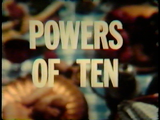Powers of Ten (film)
| Powers of Ten | |
|---|---|

Title card for the 1977 "Final" version
|
|
| Directed by | Charles and Ray Eames |
| Based on | Cosmic View (1957) by Kees Boeke (book) |
| Narrated by | Judith Bronowski (1968), Philip Morrison (1977) |
| Music by | Elmer Bernstein |
| Distributed by | IBM |
|
Release date
|
1968 ("Sketch" version) 1977 ("Final" version) |
|
Running time
|
8 min ("Sketch" version) 9 min ("Final" version) |
| Country | United States |
| Language | English |
The Powers of Ten films are two short American documentary films written and directed by Charles and Ray Eames. Both works depict the relative scale of the Universe according to an order of magnitude (or logarithmic scale) based on a factor of ten, first expanding out from the Earth until the entire universe is surveyed, then reducing inward until a single atom and its quarks are observed. The first film: A Rough Sketch for a Proposed Film Dealing with the Powers of Ten and the Relative Size of Things in the Universe — was a prototype and was completed in 1968; the second film: Powers of Ten: A Film Dealing with the Relative Size of Things in the Universe and the Effect of Adding Another Zero — was completed in 1977.
The Powers of Ten films were adaptations of the book Cosmic View (1957) by Dutch educator Kees Boeke. Both films, and a book based on the second film, follow the form of the Boeke original, adding color and photography to the black and white drawings employed by Boeke in his seminal work.
The 1977 film has a number of changes from the prototype, including being entirely in color, moving the starting location from Miami to Chicago, removing the relativistic (time) dimension, introducing an additional two powers of ten at each extreme, a change in narrator from Judith Bronowski to Philip Morrison, and much improved graphics.
In 1998, Powers of Ten (1977) was selected for preservation in the United States National Film Registry by the Library of Congress as being "culturally, historically, or aesthetically significant".
This version of the film has two clocks in the corner showing the comparison between the viewers time and that of earth time. As the viewers speed increases, earth time, relative to the viewer, also increases. It was installed in the Smithsonian Institution's National Air and Space Museum's Life in the Universe gallery at the time of the museum's opening in 1976, until the gallery's closure in 1978.
...
Wikipedia
